SG13
| Location: Mardan. | Australian Soil Classification: Acidic, Mesotrophic, Red FERROSOL. |
| Northcote Factual Key: Gn 3.11. | Great Soil Group: krasnozem. |
| Geology: Tertiary basalt. | General Landscape Description: Midslope of a hillslope (5% slope). |
| Soil Mapping Unit: Warragul. | Site Description: Roadside cutting on Holmes Road near Mardan. |
| Native Vegetation: Includes Blue Gum (Eucalyptus globulus), Blackwood (Acacia melanoxylon), Silver Wattle (Acacia dealbata) and Hazel Pomaderris (Pomaderris aspera). | |
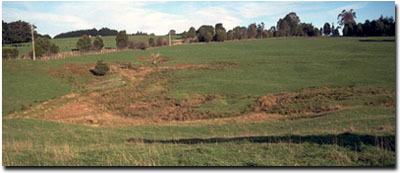 Site SG13 Landscape |
Soil Profile Morphology:
| Surface Soil | 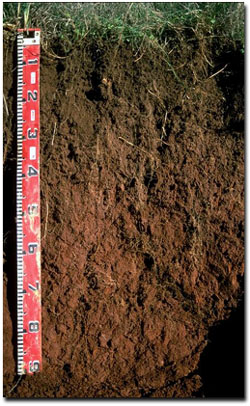 Site SG13 Profile | ||
| A1 | 0-30 cm | Dark brown (7.5YR4/4); very fine sandy clay loam; strong fine granular structure; friable consistence moist; pH 6.1; clear change to: | |
| Subsoil | |||
| B21 | 30-60 cm | Red (2.5YR4/6); clay loam to light clay (subplastic); strong polyhedral structure; firm consistence moist; pH 6.0; gradual change to: | |
| B22 | 60-90+ cm | Red (2.5YR4/6); light clay (subplastic); strong polyhedral structure; fine consistence moist; pH 5.4. | |
Key Profile Features:
- Gradual texture change throughout the profile
Soil Profile Characteristics:
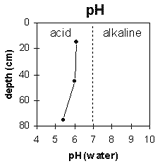 | 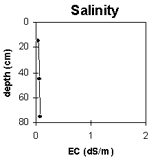 |
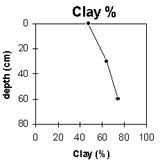 |
Horizon | Horizon Depth (cm) | pH water | pH CaCl2 | EC 1:5 | Exchangeable Cations | Ex. Al mg/kg | Ex. Acidity meq/100g | Wilting Point pF 4.2 | Coarse Sand (0.2 - 2 mm) | Fine Sand (0.02-0.2 mm) | Silt (0.002-0.02 mm) | Clay (<0.002 mm) | |||
Ca | Mg | K | Na | ||||||||||||
meq/100g | |||||||||||||||
A1 | 0-30 | 6.1 | 5.2 | 0.05 | 5.2 | 2.3 | 1.1 | 0.1 | 21 | 2 | 22 | 24 | 48 | ||
B21 | 30-60 | 6 | 5.5 | 0.06 | 4.0 | 3.1 | 0.7 | 0.1 | 22.9 | 1 | 16 | 18 | 64 | ||
B22 | 60-90 | 5.4 | 5.1 | 0.08 | 2.9 | 3.8 | 0.5 | 0.1 | <10 | 13 | 27.1 | 1 | 12 | 14 | 74 |
Management Considerations:
Whole Profile
- Ferrosols have high levels of free iron oxide which give them a high degree of structural stability.
- These soils are deep and very well drained due to their strongly developed structure. Water infiltration rates will be high unless significant compaction has occurred.
- Plant Available Water Capacity (PAWC) is considered to be moderate (estimated at approximately 138 mm) for the top metre of the soil profile. Rooting depth for a number of plants may be considerably deeper on these well-structured soils, resulting in higher PAWC values.
Surface (A) Horizons
- Due to their high iron oxide contents these soils tend to "fix" phosphorus which makes it unavailable to plants. Regular phosphorus application will assist in overcoming such a deficiency. Addition of molybdenum may also be required and this can be assessed by plant tissue analysis of clover. Zinc and copper can also be 'fixed' by high iron oxide contents.
- Coughlan et al. (1973) noted from Queensland studies of Ferrosols, that heavy applications of superphosphate can dissolve large amounts of iron and aluminium from the soil and may result in reduced aggregation.
- Compaction of these clayey soils can be caused by over-cultivation or trafficking, particularly when the soil is wetter than the plastic limit (see Appendix A). Ideally, tillage and trafficking should occur when the soil is drier than the plastic limit (at least down to the depth of cultivation). Soil compaction from trafficking can lead to reduced water infiltration and retention as well as an increase in soil strength (resulting in mechanical resistance to roots) and cloddiness. Compaction on soils such as these can be more serious than on cracking clay soils which tend to self-repair due to their strong shrink-swell capacity.
- A study by Hirst et al. (1992) of Ferrosols in the Thorpdale area found that wheel traffic has a considerable effect on soil strength (as measured by penetrometer resistance) at the beginning of the growing season. Non-ripped and retrafficked furrows were significantly more compacted to a depth of 30 cm than untrafficked or ripped furrows. This compaction resulted in reduced water infiltration (and therefore greater runoff). This has important implications for runoff and soil erosion, particularly early in the growing season when crop cover is minimal and the probability of intense storms is high. Over the course of the growing season, soil strength decreased in compacted furrows. In terms of management, it is recommended that wheel traffic be minimised (especially if the soil is wetter than the plastic limit) to prevent soil compaction. Wheel tracks and other compacted areas can be deep ripped (when dry) or cultivated across the slope to promote infiltration and minimise the potential for runoff.
- When cultivated in a too moist condition such soils can be prone to form large clods. These can create difficulties when harvesting potatoes. A decline in organic matter levels may also contribute to clod development.
- Red Ferrosols (krasnozems) have a high pH buffering capacity (i.e. require a larger lime application to raise soil pH). However, over-liming may result in some micronutrient deficiencies and may result in reduced aggregate stability.
- This soil has a reasonably high organic matter content. Red Ferrosols generally have high organic matter levels which enhances soil fertility and aggregate stability. When intensively cropped, organic matter levels will decline and this will result in some structural degradation and fertility decline. Studies have shown that organic matter is an important source of nitrogen, phosphorus and sulphur in such soils. Organic matter levels can be improved by utilising green manure crops, crop residue retention, minimal cultivation and pasture rotations.
- Management practices which result in increased organic matter levels include: minimum tillage; growing green manure crops (e.g. annual ryegrass, sorghum, oats, lupins); incorporating pasture phases in crop rotations, and retaining and incorporating crop residues (Cotching 1995).
- The nutrient status (based on the sum of the exchangeable basic cations) of these strongly leached soils is not high (particularly below the surface horizon). Fertiliser input is often needed if intensive cropping is to take place. Organic matter is a major source of cation exchange in such soils.
Subsoil (B) Horizons
- The subplastic properties of the subsoil can lead to problems with sealing of earth dams. Sealing of dams constructed on such soils can be achieved by compaction at the optimum water content and treatment with sodium tri-polyphosphate or addition of bentonite (Rolfe 1989).
Note: For an excellent review paper on management of Ferrosols refer to Cotching (1995). Also, the results of a study of land management effects on the structure of Ferrosols in this region has been presented by Hirst et al. (1992).
References
Cotching, B. (1995). Long term management of krasnozems in Australia. Aust. J. Soil and Water Cons. 8:1 (pp 18-27).
Coughlan, K.J; Fox, W.E. and Hughes, J.D. (1973). A study of the mechanisms of aggregation in a krasnozem soil. Aust. J. Soil Res. 11: 65-73.
Hirst, K.M; Imhof, M.P. and Weston, B.A. (1992). The effect of land management on the structure of intensively cropped soils in West Gippsland. Research Report series No. 138. Department of Agriculture.
Rolfe, L. (1989). Sealing earth dams in red krasnozems of the Lismore area. NSW Agriculture and Fisheries. Agdex 586.
Sargeant, I.J. and Skene, J.K.M. (1970). Some properties of the krasnozems of southern Victoria, Australia. Aust. J. Soil Res. 8: 281-295.


